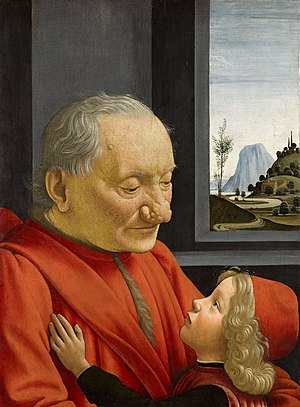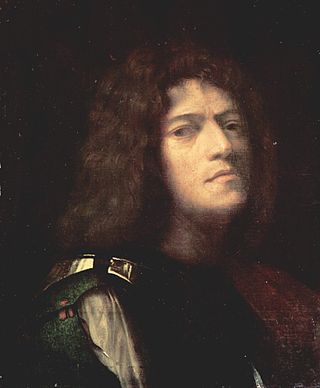
Giorgione was an Italian painter of the Venetian school during the High Renaissance, who died in his thirties. He is known for the elusive poetic quality of his work, though only about six surviving paintings are firmly attributed to him. The uncertainty surrounding the identity and meaning of his work has made Giorgione one of the most mysterious figures in European art.

Domenico di Tommaso Curradi di Doffo Bigordi, professionally known as Domenico Ghirlandaio, also spelt as Ghirlandajo, was an Italian Renaissance painter born in Florence. Ghirlandaio was part of the so-called "third generation" of the Florentine Renaissance, along with Verrocchio, the Pollaiolo brothers and Sandro Botticelli. Ghirlandaio led a large and efficient workshop that included his brothers Davide Ghirlandaio and Benedetto Ghirlandaio, his brother-in-law Bastiano Mainardi from San Gimignano, and later his son Ridolfo Ghirlandaio. Many apprentices passed through Ghirlandaio's workshop, including the famous Michelangelo. His particular talent lay in his ability to posit depictions of contemporary life and portraits of contemporary people within the context of religious narratives, bringing him great popularity and many large commissions.

Filippino Lippi was an Italian painter working in Florence, Italy during the later years of the Early Renaissance and first few years of the High Renaissance.

Lorenzo Lotto was an Italian painter, draughtsman, and illustrator, traditionally placed in the Venetian school, though much of his career was spent in other north Italian cities. He painted mainly altarpieces, religious subjects and portraits. He was active during the High Renaissance and the first half of the Mannerist period, but his work maintained a generally similar High Renaissance style throughout his career, although his nervous and eccentric posings and distortions represented a transitional stage to the Florentine and Roman Mannerists.
Andrea Solari (1460–1524) was an Italian Renaissance painter of the Milanese school. He was initially named Andre del Gobbo, but more confusingly as Andrea del Bartolo a name shared with two other Italian painters, the 14th-century Siennese Andrea di Bartolo, and the 15th-century Florentine Andrea di Bartolo.

Ridolfo di Domenico Bigordi, better known as Ridolfo Ghirlandaio was an Italian Renaissance painter active mainly in Florence. He was the son of Domenico Ghirlandaio.
Francesco Botticini was an Italian painter of the Early Renaissance. He was born in Florence, where he remained active until his death in 1498. Although there are only few documented works by Botticini, a considerable corpus has been confidently attributed to him on the basis of style including a number of altarpieces, dozens of small-scale religious panels and a few portraits.
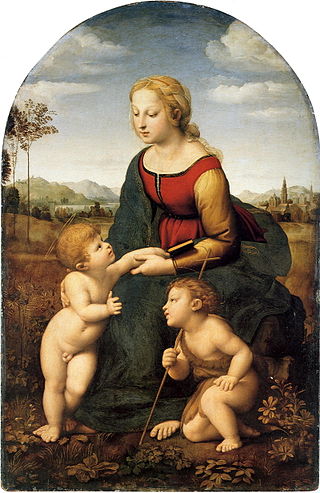
La Belle Jardinière, also known as the Madonna and Child with Saint John the Baptist, is a painting started by the Italian High Renaissance artist Raphael, and finished by Ridolfo del Ghirlandaio, that depicts the Madonna, a young Christ, and a young John the Baptist. It is believed to have been commissioned by the Sienese patrician Fabrizio Sergardi in approximately 1507. It is currently displayed in the Louvre Museum in Paris, France.

The Entombment is an unfinished oil-on-panel painting of the burial of Jesus, now generally attributed to the Italian Renaissance master Michelangelo Buonarroti and dated to around 1500 or 1501. It is in the National Gallery in London, which purchased the work in 1868 from Robert Macpherson, a Scottish photographer resident in Rome, who, according to various conflicting accounts, had acquired the painting there some 20 years earlier. It is one of a handful of paintings attributed to Michelangelo, alongside the Manchester Madonna, the Doni Tondo, and possibly, The Torment of Saint Anthony.
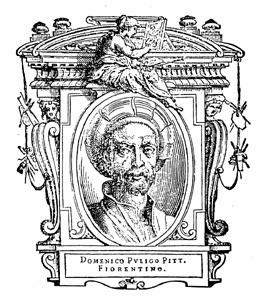
Domenico Puligo (1492–1527) was an Italian painter of the Renaissance, active in Florence. His real name was Domenico di Bartolomeo Ubaldini.

Florentine painting or the Florentine School refers to artists in, from, or influenced by the naturalistic style developed in Florence in the 14th century, largely through the efforts of Giotto di Bondone, and in the 15th century the leading school of Western painting. Some of the best known painters of the earlier Florentine School are Fra Angelico, Botticelli, Filippo Lippi, the Ghirlandaio family, Masolino, and Masaccio.

The Sassetti Chapel is a chapel in the basilica of Santa Trinita in Florence, Italy. It is especially notable for its frescoes of the Stories of St. Francis, considered Domenico Ghirlandaio's masterwork.
The decade of the 1480s in art involved some significant events.

This article about the development of themes in Italian Renaissance painting is an extension to the article Italian Renaissance painting, for which it provides additional pictures with commentary. The works encompassed are from Giotto in the early 14th century to Michelangelo's Last Judgement of the 1530s.
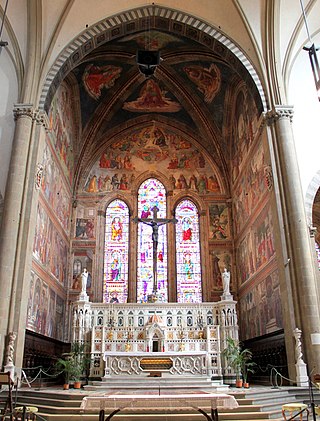
The Tornabuoni Chapel is the main chapel in the church of Santa Maria Novella, Florence, Italy. It is famous for the extensive and well-preserved fresco cycle on its walls, one of the most complete in the city, which was created by Domenico Ghirlandaio and his workshop between 1485 and 1490.
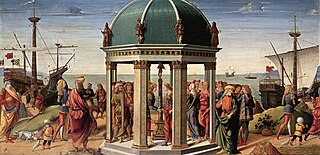
Biagio d’Antonio Tucci was an Italian Renaissance painter active in Florence, Faenza and Rome.

Bartolomeo di Giovannidi Domenico was an Italian Renaissance painter active in Florence. His works were first identified by the art historian Bernard Berenson, who did not know the painter's real name so called him the "Alunno di Domenico". This name was based on Berenson's observation that the painter executed the predella of Ghirlandaio's Adoration of the Magi (1488) in the Ospedale degli Innocenti, the foundling hospital in Florence. Archival research later yielded the painter's real name as Bartolomeo di Giovanni. Bartolomeo also collaborated with Sandro Botticelli.

The Visitation is a painting by the Italian Renaissance painter Domenico Ghirlandaio, dating 1491. It is displayed in the Louvre Museum of Paris, France.

The Libro de' Disegni was a collection of drawings gathered, sorted and grouped by Giorgio Vasari whilst writing his Lives of the Most Excellent Painters, Sculptors, and Architects. By the time of his death in 1574 it is thought to have contained around 526 drawings, of which 162 are now in the Louvre and 83 in the Nationalmuseum, Stockholm. There are also drawings from the Libro in the prints and drawings departments of the Uffizi, the British Museum, the Albertina, the National Gallery of Art and other institutions.
